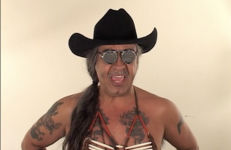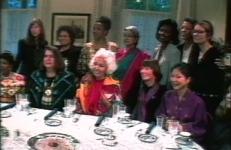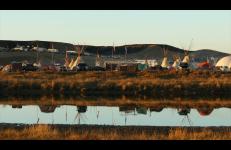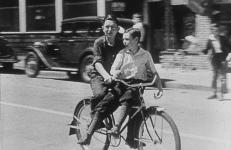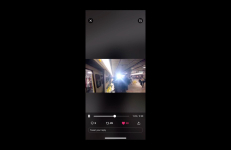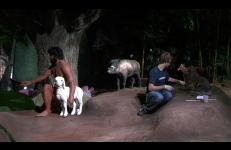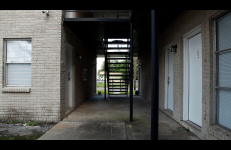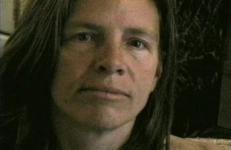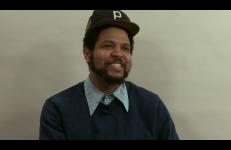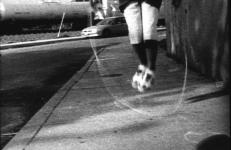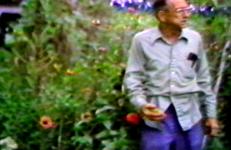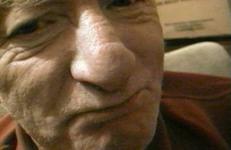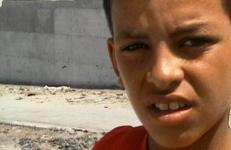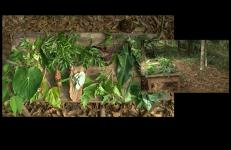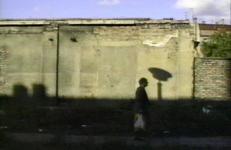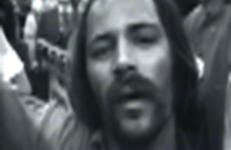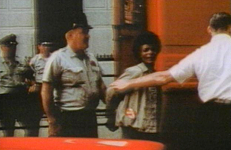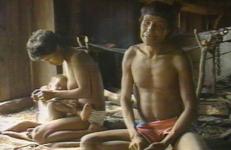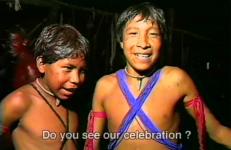As a "Post-Mexican” performance artist operating out of the US for over 20 years, one of my conceptual obsessions has been to constantly reposition myself within the hegemonic maps. Whether this map is the Americas, the larger cartography of art, or my personal biography, one of my jobs has been to move around, cross dangerous borders, disappear and reappear somewhere else, and in the process create "imaginary cartographies” capable of containing the complexities of my multiple and ever-changing identities, voices, communities and performative bodies.
Documentary
As a "Post-Mexican” performance artist operating out of the US for over 20 years, one of my conceptual obsessions has been to constantly reposition myself within the hegemonic maps. Whether this map is the Americas, the larger cartography of art, or my personal biography, one of my jobs has been to move around, cross dangerous borders, disappear and reappear somewhere else, and in the process create "imaginary cartographies” capable of containing the complexities of my multiple and ever-changing identities, voices, communities and performative bodies.
Executive produced by Sara Diamond at the Banff Art Centre, co-produced by Michelle Baughn and Suzanne Lacy, directed by Tom Weinberg and Dick Carter, and edited by Holen Kahn.
An incomplete and imperfect portrait of reflections from Standing Rock. Cleo Keahna recounts his experiences entering, being at, and leaving the camp and the difficulties and the reluctance in looking back with a clear and critical eye. Terry Running Wild describes what his camp is like, and what he hopes it will become.
This film uses the ‘old fashioned’ conventions of documentary film practice to stand history on its head. There is a narration taken from a radio lecture by Claude Lévi-Strauss entitled, “The Meeting of Myth and Science,” images from the Deutsche Wochenshau of June 25, 1940 that recorded Hitler’s dawn visit to Paris, images from American newsreels, a movement from one of Beethoven’s Rasumovsky Quartets. The film could only succeed, in my mind, if the imprint of prior usage of all elements was clear.
Do Not Circulate, an experimental short film, attempts a structuralist and materialist approach to unraveling the entrails of a collective media memory. Paced by an essay as a relentless voiceover, the film rips footage that challenges the materiality, ownership and legal boundaries of documentation.
The Earth Is Young takes as its starting point a series of interviews conducted with Young Earth Creationists, who find evidence of a six-day, six-thousand-year old creation in their reading of the fossil and geological record. The film frames these encounters with depictions of the slow and patient work of young paleontologists, and the strange, shimmering life in a drop of pond water, both of which point toward a world far older and more complex, if no less fantastic.
From below ground, a man named Eddie describes flood lines, levees and trivial histories of the crumbling infrastructure of Memphis, TN. In this same city, the filmmaker, a recent transsexual transplant, watches military propaganda and contemplates masculine connectivity as he attempts to integrate into the American South. He posts a Craigslist ad asking men to masturbate on-camera with their firearms. He receives a single response from a man whose name is also Eddie.
This video is an unabashed fan letter to poet Eileen Myles. As in Laurie, my desire was to romanticize the poet, but not through her writing so much as through her reputation as the natural born child of the New York School and the Beats. I shot the movie as I imagined Robert Frank and Alfred Leslie shooting Pull My Daisy, a film that left an impression on me chiefly of the struggle between form and formlessness, plan and improvisation, sketch and story.
In this interview, African American filmmaker and DJ Ephraim Asili (b. 1979) discusses his upbringing, education, and creative process. Born and raised around the city limit of Philadelphia, Asili’s childhood and adolescence were imbued with hip hop music, Hollywood movies and television.
Exit Interview is a tragi-comedy about obsolescence. A shrinking community’s resident documentary filmmaker is being fired.
In order of appearance: James Carter, Donigan Cumming, Colin Kane, Raymond Beaudoin, James Weber, Pierre Lamarche, Gerald Harvey, Rawson Hill
A pileup of human refuse and super-human powers permeates this hour-long canvas of bits and pieces documenting the smash-up of a house of healing, as the physicians in charge short circuit amid the electronic wizardry beyond the Panasonic barrier. Made with my students.
Fifeville is a film about a neighborhood in Charlottesville, Virginia. It focuses on the details, gestures, and material life of the citizens of Fifeville as they communicate their understandings of the neighborhood’s changing landscape. Although Fifeville is set in Charlottesville, it could be Any Black Community Experiencing Gentrification, USA, 21st Century.
Co-director: Corey D.B. Walker. Crew: bh103a.
Reverend Howard Finster was a preacher-turned-folk artist. He created Paradise Gardens Park & Museum, a product of all his murals, drawings, sculptures, and mosaics—and Summerville, Georgia’s largest tourist attraction. He began Paradise Gardens around 1961; in 1976 he responded to a vision to paint sacred art. As this video begins, Finster is painting with his hands in his studio. Finster then embarks on his first visit to New York City and comments upon his exhibition at Phyllis Kind Gallery. He spins rhythmic narratives that turn into miniature sermons.
An alcoholic, emaciated father; a grossly obese, tattooed mother; a goofy, hormone-addled brother—all together in a claustrophobic council flat. Welcome to the Billinghams'. Richard Billingham wowed the art scene with his book Ray's A Laugh. Fishtank, his first film, charts the emotional territory of the flat and the family who play out their lives within its confines.
Forbidden to Wander chronicles the experiences of a 25-year-old Arab American woman traveling on her own in the occupied territories of the West Bank and Gaza Strip during the summer of 2002. The film is a reflection on the complexity of Palestinian existence and the torturously disturbing “ordinariness” of living under constant curfew. The film’s title reflects this, as the Arabic words used to describe the imposed curfew “mane’ tajawwul” literally translate as “forbidden to wander”.
Forest Law underlines the persistent fact that we are yet to learn to live otherwise in an age defined by the colossal consequences of a new socio-geological order we ourselves have created through irresponsible interactions with Earth’s systems.
Former East/Former West was shot in Berlin three years after German reunification. Comprised largely of street interviews conducted in various parts of the city, the video documents Berliners' feelings about their national identity. For forty years, people in this divided city lived radically different lives—ideologically, economically, socially and politically. These differences were also reflected in their everyday routines, relationships and experiences, leading Silver to ponder what the two Germanys have in common, aside from language.
TVTV's inside view of the 1972 Republican National Convention made broadcast history. While network cameras focused on the orchestrated renomination of Richard Nixon, TVTV's rag-tag army of guerrilla television activists turned their cameras on to the cocktail parties, anti-war demonstrations, hype and hoopla that accompanied the show.
In the words of activist Dhoruba Bin Wahad, “Historical and social events are subject to almost instant censorship by those who have better access and control over the medium of communication. It is important that there exist people skilled in the use of the technological instruments of communication who will seek out the real truth behind the headlines and tell it for all to see, know, and hear.”
In the words of activist Dhoruba Bin Wahad, “Historical and social events are subject to almost instant censorship by those who have better access and control over the medium of communication. It is important that there exist people skilled in the use of the technological instruments of communication who will seek out the real truth behind the headlines and tell it for all to see, know, and hear.”
Over 6,000 gold prospectors invade the reserve of the Nambiquara of Sararé, and loggers raid the mahogany-rich forests, which are threatened by extinction. Pressure on the World Bank (with whom the government of Mato Grosso is negotiating a loan) could end prospecting, but the pillage of the forest continues.
In Portuguese with English subtitles.
Directed by Vincent Carelli, Maurizio Longobardi, and Virginia Valadão; edited by Tutu Nunes.
Over 6,000 gold prospectors invade the reserve of the Nambiquara of Sararé, and loggers raid the mahogany-rich forests, which are threatened by extinction. Pressure on the World Bank (with whom the government of Mato Grosso is negotiating a loan) could end prospecting, but the pillage of the forest continues.
In Portuguese with English subtitles.
Directed by Vincent Carelli, Maurizio Longobardi, and Virginia Valadão; edited by Tutu Nunes.
Over 6,000 gold prospectors invade the reserve of the Nambiquara of Sararé, and loggers raid the mahogany-rich forests, which are threatened by extinction. Pressure on the World Bank (with whom the government of Mato Grosso is negotiating a loan) could end prospecting, but the pillage of the forest continues.
In Portuguese with English subtitles.
Directed by Vincent Carelli, Maurizio Longobardi, and Virginia Valadão; edited by Tutu Nunes.
Four Ikpeng children reply to a video-letter from the children of Sierra Maestra in Cuba, introducing their village, families, toys, celebrations, and ways of life with grace and lightheartedness. Curious to know about children from other cultures, they ask to continue the correspondence.
Direction and camera by Karané, Kumaré, and Natuyu Yuwipo Txicão; edited by Mari Corrê.




